-
info@aaanimalcontrol.com
Call us for help in your town
Humane Wildlife Education
Common Wildlife Pests We Handle
For more info on any of these animals, just click the "more" link after each description.
Below are brief descriptions of the most common nuisance wildlife species found in the United States. These animals typically have a habit of living on or even in human homes and environments.
They often thrive in heavily populated areas, and take advantage of human buildings and food sources. Many of these animals can be found living in the attics of homes. At the end of each animal
description, you can click a link for more information about that particular species. My site is loaded with professional wildlife pest control photos, as well as critter blogs, and of course our
directory of hundreds of wildlife control experts located in every city of the country. If you need pest wildlife removal in your hometown, we service over 500 USA locations!
Click here to hire us in your town and check prices - updated for year 2020.
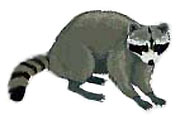 RACCOON: Raccoons are a common nuisance wildlife species. They frequently enter attics and other parts of homes. They are
strong and capable of causing quite a bit of destruction to homes and attics. Female raccoons often enter houses in order to have their young in the springtime. Raccoons are responsible for a
number of nuisance problems, from stealing pet food, to tipping over garbage cans, to raiding ornamental ponds, chicken coops, etc. They are very crafty and capable animals. They typically weigh
10-25 pounds as adults, and are usually larger in northern latitudes. They eat almost anything, and are primarily active at night. ...read more
RACCOON: Raccoons are a common nuisance wildlife species. They frequently enter attics and other parts of homes. They are
strong and capable of causing quite a bit of destruction to homes and attics. Female raccoons often enter houses in order to have their young in the springtime. Raccoons are responsible for a
number of nuisance problems, from stealing pet food, to tipping over garbage cans, to raiding ornamental ponds, chicken coops, etc. They are very crafty and capable animals. They typically weigh
10-25 pounds as adults, and are usually larger in northern latitudes. They eat almost anything, and are primarily active at night. ...read more
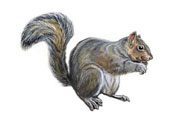 EASTERN GRAY SQUIRREL: While many types of squirrels can cause nuisance problems, from red squirrels to flying squirrels, the
Eastern Grays are the most common. They love to live in the attics of buildings, usually in the winter and later summer, when females give birth to their bi-annual litter of young. They are expert
chewers, and will chew their way in, as well as chew on wires once inside. They primarily eat nuts and grains, and will store these in the attic or walls, along with nesting debris. They are most
active in morning and evening times. These squirrels typically only live a few years in the wild. ...read more
EASTERN GRAY SQUIRREL: While many types of squirrels can cause nuisance problems, from red squirrels to flying squirrels, the
Eastern Grays are the most common. They love to live in the attics of buildings, usually in the winter and later summer, when females give birth to their bi-annual litter of young. They are expert
chewers, and will chew their way in, as well as chew on wires once inside. They primarily eat nuts and grains, and will store these in the attic or walls, along with nesting debris. They are most
active in morning and evening times. These squirrels typically only live a few years in the wild. ...read more
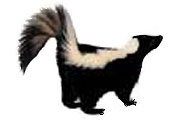 STRIPED SKUNK: Skunks are well known for their strong odor. They frequently choose to live under homes and decks, sheds, or porches.
They cause a problem with their odor, particularly during the mating season. They also often fall down window wells and get stuck. There are several skunk species in North America, but their behavior
is relatively similar. They are nocturnal and ominvorous. They frequently choose to den underneath homes, and they are not particularly fast, so there's a good chance your dog will catch one and get
sprayed. ...read more
STRIPED SKUNK: Skunks are well known for their strong odor. They frequently choose to live under homes and decks, sheds, or porches.
They cause a problem with their odor, particularly during the mating season. They also often fall down window wells and get stuck. There are several skunk species in North America, but their behavior
is relatively similar. They are nocturnal and ominvorous. They frequently choose to den underneath homes, and they are not particularly fast, so there's a good chance your dog will catch one and get
sprayed. ...read more
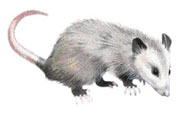 OPOSSUM: Opossums are a common nuisance species because they are opportunistic, and will take advantage of human homes, sheds,
decks, etc in order to live and steal food. They are marsupials, and the young grow in a pouch in spring. I commonly find them in the attics of homes, and they are also a common dead animal
extraction target. They are interesting: they have the most teeth of any mammal (50), a prehensile tail, opposable thumbs, the male has a bifurcated penis, they can eat almost anything, and they
have incredible immune systems, all of which make them great survivors, despite their tiny brain. ...read more
OPOSSUM: Opossums are a common nuisance species because they are opportunistic, and will take advantage of human homes, sheds,
decks, etc in order to live and steal food. They are marsupials, and the young grow in a pouch in spring. I commonly find them in the attics of homes, and they are also a common dead animal
extraction target. They are interesting: they have the most teeth of any mammal (50), a prehensile tail, opposable thumbs, the male has a bifurcated penis, they can eat almost anything, and they
have incredible immune systems, all of which make them great survivors, despite their tiny brain. ...read more
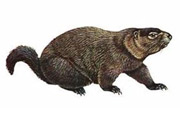 GROUNDHOG (WOODCHUCK): A common nuisance species in the more northern states, groundhogs dig large burrows which are often
complex, with several entry holes. Groundhogs are rodents, and adults average 8-10 pounds. They give birth in spring to 3-6 young. They are primarily herbivorous, eating a variety of plants,
including your garden, which is one of the major complaints. They grow fat during the summer, and in winter, they hibernate. They are usually considered a pest due to their burrowing behavior.
They are active during the day. ...read more
GROUNDHOG (WOODCHUCK): A common nuisance species in the more northern states, groundhogs dig large burrows which are often
complex, with several entry holes. Groundhogs are rodents, and adults average 8-10 pounds. They give birth in spring to 3-6 young. They are primarily herbivorous, eating a variety of plants,
including your garden, which is one of the major complaints. They grow fat during the summer, and in winter, they hibernate. They are usually considered a pest due to their burrowing behavior.
They are active during the day. ...read more
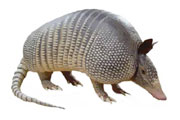 NINE BANDED ARMADILLO: These are common nuisance species in the southern states, where they cause problems with their tendency
to burrow large holes into the ground. They also dig up yards and landscaping as they search for worms and grubs. They are a unique animal - they can carry leprosy, they always give birth to four
identical quadruplets, and they of course have a hard, bony shell. They tend to grow to adult size of about 12 pounds in the first year, then live for a long time. They are usually nocturnal, though
sometimes active during the day. ...read more
NINE BANDED ARMADILLO: These are common nuisance species in the southern states, where they cause problems with their tendency
to burrow large holes into the ground. They also dig up yards and landscaping as they search for worms and grubs. They are a unique animal - they can carry leprosy, they always give birth to four
identical quadruplets, and they of course have a hard, bony shell. They tend to grow to adult size of about 12 pounds in the first year, then live for a long time. They are usually nocturnal, though
sometimes active during the day. ...read more
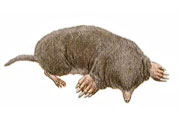 MOLES: There are several mole species in North America, and the Eastern Mole is one of the most common pest moles. All
moles live under ground and dig a network of tunnels and chambers. They create surface tunnels and deep tunnels dirt mounds under the living chambers. Moles are small, weighing only about 3-5 oz.
and about 6-8 inches long, but they are great diggers with voracious appetites. They primarily eat earthworms, and also other underground insects. They live for about 3 years. They breed in the
winter, but aside from mating, most moles are territorial. They are considered a pest due to their digging. ...read more
MOLES: There are several mole species in North America, and the Eastern Mole is one of the most common pest moles. All
moles live under ground and dig a network of tunnels and chambers. They create surface tunnels and deep tunnels dirt mounds under the living chambers. Moles are small, weighing only about 3-5 oz.
and about 6-8 inches long, but they are great diggers with voracious appetites. They primarily eat earthworms, and also other underground insects. They live for about 3 years. They breed in the
winter, but aside from mating, most moles are territorial. They are considered a pest due to their digging. ...read more
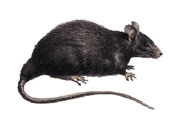 RATS: The two common rats species in North America are the Roof Rat and the Norway Rat. Roof Rats are smaller, with adults usually
weighing 6-10 oz. with a body of 8 inches and a tail of 8 inches. Roof Rats tend to live in warmer areas and inhabit areas above ground, such as in trees. The Norway Rats weigh from 10-16 oz, with a 9 inch body and a shorter tail. Norways live in cooler climates and live at ground level. Neither specie lives very long, rarely more than a year in the wild. They can breed year-round, and produce litters of up to ten young up to five times per
year. Both will eat a wide variety of foods, and are considered pests for many reasons, such as their tendency to spread disease. ...read more
RATS: The two common rats species in North America are the Roof Rat and the Norway Rat. Roof Rats are smaller, with adults usually
weighing 6-10 oz. with a body of 8 inches and a tail of 8 inches. Roof Rats tend to live in warmer areas and inhabit areas above ground, such as in trees. The Norway Rats weigh from 10-16 oz, with a 9 inch body and a shorter tail. Norways live in cooler climates and live at ground level. Neither specie lives very long, rarely more than a year in the wild. They can breed year-round, and produce litters of up to ten young up to five times per
year. Both will eat a wide variety of foods, and are considered pests for many reasons, such as their tendency to spread disease. ...read more
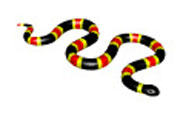 SNAKES: North America is home to many snake species, about 130. Most are harmless. There's 20 venomous species of snake, most of
them rattlesnakes. The exceptions are the aquatic snakes, such as the Copperhead and the Cottonmouth, and the Coral Snakes (the red-yellow-black ones). If you are unsure of the specie of snake, just
leave it alone! In fact, leave all snakes alone. They get a bad rap. If one gets in your house or pool or something, a wildlife specialist can come and remove it, but otherwise, it's probably not
bad to have around, so leave it be. Snakes vary greatly in mating behavior, life span, etc, so I won't list any stats here. ...read more
SNAKES: North America is home to many snake species, about 130. Most are harmless. There's 20 venomous species of snake, most of
them rattlesnakes. The exceptions are the aquatic snakes, such as the Copperhead and the Cottonmouth, and the Coral Snakes (the red-yellow-black ones). If you are unsure of the specie of snake, just
leave it alone! In fact, leave all snakes alone. They get a bad rap. If one gets in your house or pool or something, a wildlife specialist can come and remove it, but otherwise, it's probably not
bad to have around, so leave it be. Snakes vary greatly in mating behavior, life span, etc, so I won't list any stats here. ...read more
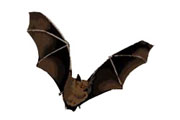 BATS: The three most common nuisance (colonizing) species in the US are the Little Brown Bat, the Big Brown Bat, and the Mexican
Free-Tail Bat. The former two are common in the more northern states, and the free-tail in the southern states. These bats usually cause a problem when they establish large maternity colonies inside
buildings. There, they leave behind their droppings, often in great bulk. Bats are special animals - they are of course mammals, and they give birth to one young each year. They live for a long time
in the wild, up to 18 years. They eat millions of insects and are usually docile. A good wildlife expert can remove them without harming them. ...read more
BATS: The three most common nuisance (colonizing) species in the US are the Little Brown Bat, the Big Brown Bat, and the Mexican
Free-Tail Bat. The former two are common in the more northern states, and the free-tail in the southern states. These bats usually cause a problem when they establish large maternity colonies inside
buildings. There, they leave behind their droppings, often in great bulk. Bats are special animals - they are of course mammals, and they give birth to one young each year. They live for a long time
in the wild, up to 18 years. They eat millions of insects and are usually docile. A good wildlife expert can remove them without harming them. ...read more
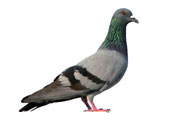 PIGEON: Feral pigeons are very common in urban areas, and a common and well-known city pest. Though some people like to feed them they
create a mess with their nesting material and feathers, but most of all, with their droppings, which are unsanitary and which may pose a health hazard. Pigeons weigh about a pound and tend to live for
3-5 years in the wild. They nest at any time of the year, and mate for life. The young hatch only 19 days after the eggs are laid. Pigeons eat a variety of foods. They are usually removed from roosting
areas such as beams, store signs, inside buildings, etc. ...read more
PIGEON: Feral pigeons are very common in urban areas, and a common and well-known city pest. Though some people like to feed them they
create a mess with their nesting material and feathers, but most of all, with their droppings, which are unsanitary and which may pose a health hazard. Pigeons weigh about a pound and tend to live for
3-5 years in the wild. They nest at any time of the year, and mate for life. The young hatch only 19 days after the eggs are laid. Pigeons eat a variety of foods. They are usually removed from roosting
areas such as beams, store signs, inside buildings, etc. ...read more
Other nuisance wildlife species include:
- BEAVERS - Usually cause a problem by constructing dams and causing flooding. Can be trapped and removed.
- FOX OR COYOTE - Can prey on chickens or other domestic animals. Mostly harmless, but sometimes a problem.
- STRAY CATS - Some companies deal with feral cats, sometimes it's just up to the local county to do it.
- FLYING SQUIRRELS - Nocturnal colonizing species, they will live in attics in large numbers and make noise.
- DEAD ANIMALS - Oftentimes critters die inside of homes, and then they cause a terrible odor problem.
How To Guide: do it yourself! - Advice on saving money by doing wildlife removal yourself.
How To Guide: Who should I hire? - What questions to ask, what to look for, who NOT to hire.
Guide: How much does wildlife removal cost? - Analysis of the wildlife control business, & prices.
OTHER ANIMALS - I have written guides for several less common nuisance wildlife species:
How To Get Rid of Mice
How To Get Rid of Fox
How To Get Rid of Coyotes
How To Get Rid of Chipmunks
How To Get Rid of Voles
How To Get Rid of Deer
How To Get Rid of Flying Squirrels
How To Get Rid of Gophers
How To Get Rid of Prairie Dogs
How To Get Rid of Feral Pigs
How To Get Rid of Alligators
How To Get Rid of Iguanas
How To Get Rid of Muskrats
How To Get Rid of Nutria
How To Get Rid of Otters
How To Get Rid of Pigeons
How To Get Rid of Goose
How To Get Rid of Muscovy
How To Get Rid of Starlings
How To Get Rid of Woodpecker
How To Get Rid of Porcupines
How To Get Rid of Rabbits
How To Get Rid of Weasels
How To Get Rid of Stray Dogs
How To Get Rid of Frogs
How To Get Rid of Lizards
How To Get Rid of Bobcats
This site also contains several advice articles regarding nuisance wildlife conflicts. For example, check out my comprehensive guides to animals in the attic, rats in the walls, mice in the walls, squirrels in the attic, raccoons in the attic, and more. I also advise people not to feed the wildlife, in order to avoid animal conflicts.
This site contains hundreds of informational articles about wildlife removal. However, for even more unique wildlife advice, over 1000 articles on every wildlife removal topic, visit how to get rid of pests, an excellent resource for all things related to wildlife control. This site is also mobile-friendly, unlike aaanimalcontrol, which I didn't feel like completely overhauling.








































